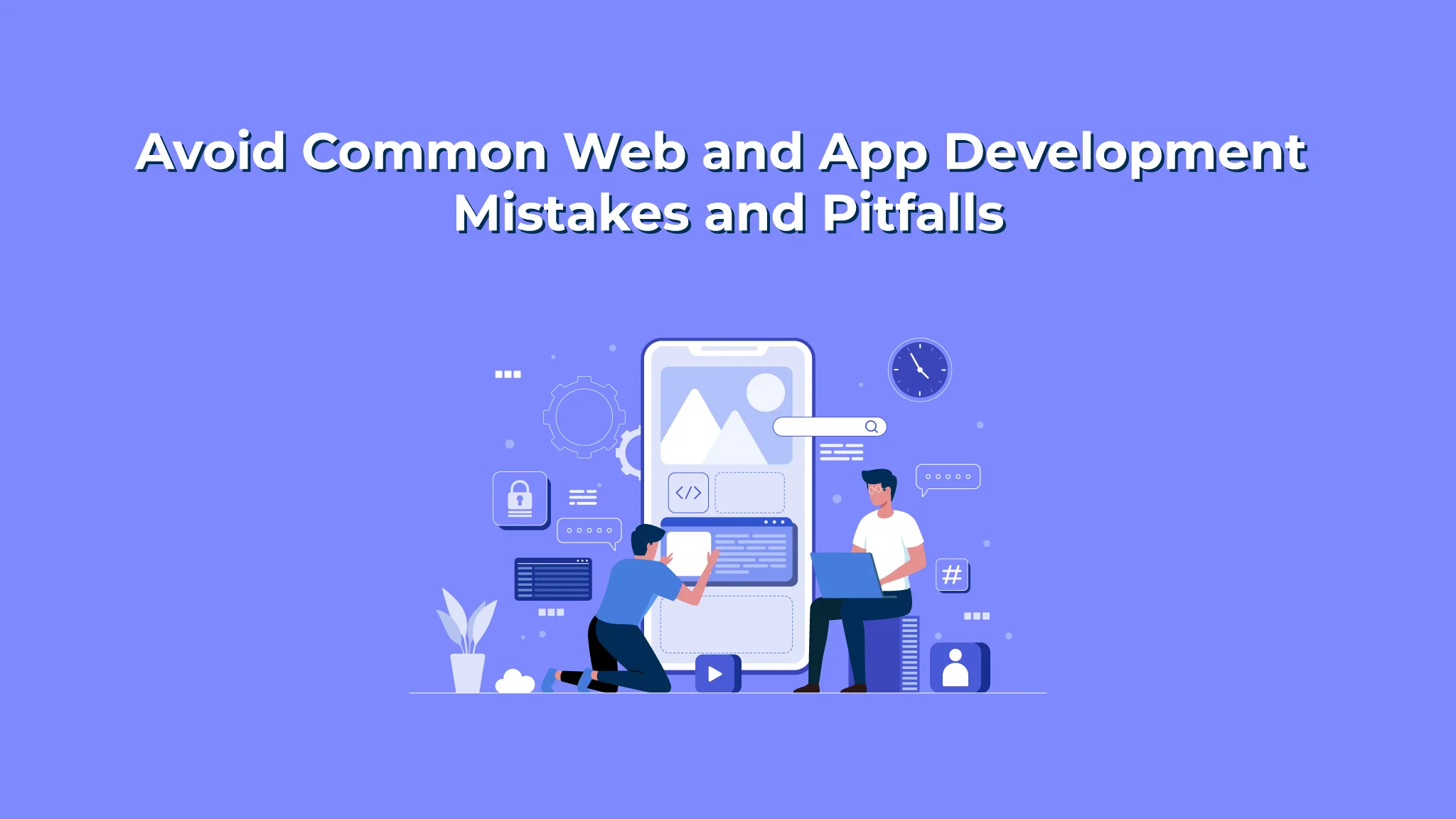How to Avoid Common Web and App Development Mistakes and Pitfalls
Web and app development are evolving necessary components for both someone and companies in the digital age. A company’s development and reputation can be greatly impacted by developing a good website or application. But there are hardships in the expansion procedure as well. We’ve gathered crucial advice on avoiding typical errors and dangers to assist you as you traverse the complexities of web and app development. To make sure that your development path is successful and seamless, let’s explore these crucial insights.
Thoroughly Plan Your ProjectBefore diving into the development process, it is essential to have a comprehensive plan in place. Define your project’s scope, objectives, target audience, and expected outcomes. Involve key stakeholders to gain valuable insights and ensure everyone is on the same page. A well-defined plan serves as a roadmap, reducing the chances of misunderstandings and deviations during development.
We’ve put together a checklist of errors people frequently make while creating websites to assist you make sure you’re covering all the bases. Here, Kenny Lin, the domain manager at Codecademy, discusses several typical developer errors and how to prevent them.

Coding without a plan
You need a strategy before you start building website code: What is the purpose of this website? Says Kenny. “What does it do?” You can avoid wasting time developing a website that isn’t genuinely focused on a certain purpose by determining what you’re attempting to accomplish upfront.
Consider the scenario where you want to create a website to market a side business or interest, such as photography or a personal blog. In that situation, according to Kenny, employing a lower-code solution like Wix might be more effective than creating a website from scratch. For instructions, see our Create a Professional Website with Velo by Wix course.
When you’ve decided what you want your website to do, Kenny suggests writing down your plans. Make a wireframe of your website’s configuration, including where the text, illustrations, and other components will be placed. Your major goal at this point is to identify your MVP or a version of your product that can be completed with a lot less effort than the ideal state you have in mind. The argument is that it can be improved later and is good sufficiently to help you in attaining your plans.
Leaving vulnerabilities open
Anyone running a website must take security and privacy into account. Web development is consequently becoming more and more concerned with security and privacy. You must therefore ensure that the information about your users is secure.
Kenny advises using HTTPS (Hypertext Transfer Protocol Secure) as a starting point. This internet communication protocol helps against man-in-the-middle cyberattacks by encrypting data transferred between servers and browsers.
Subsequently, you should check to notice if all of your code—including any gadgets and plugins—is present. Developers occasionally uncover security holes that attackers can use to access systems and confidential data. (Recall the log4j crisis from the prior year. Numerous systems and devices, including those used by prestigious corporations like Google, IBM, and Microsoft, were in danger due to a vulnerability discovered in the widely used Java library by developers.)
Furthermore, Kenny mentions that certain web hosting companies offer security tools like Cloudflare, which blocks shady IP addresses from accessing your website. To understand better about cyberattacks and how to guard against them, consider our Fundamentals of Cybersecurity skill path if you want to delve more in-depth.
Missing accessibility features
According to Kenny, accessibility policies and features are essential for ensuring an equitable user experience. How successfully can people with sensory, motor, or cognitive limitations use your website? Can screen readers read your HTML? Do you have captions for your video content? Are your icons sufficiently spread apart or are they too closely packed together?
Including accessibility features expands your potential user base and is morally responsible. For further information, see the accessibility section in our Learn Intermediate CSS course.
Overlooking user data
If you aren’t already, you should start employing data analytics tools. User information contains a wealth of useful information that may be used to identify issue areas and make your site more functional. mentions programs like HotJar, which provides both free and commercial packages, that can help you learn more about how visitors interact with your website by tracking things like where their cursors tend to hover over, what they click on, and how long they stay on particular pages.
You might want to spruce it up with extra resources if something is really popular.” You may find flaws on your website that you missed while you were coding it by watching how actual users interact with it.
The lesson of the tale? You can learn more about your users with the use of data analytics. You may understand more about the demographics of your users by utilizing tools like Google Analytics. With this knowledge, you may adjust your website to appeal to other demographics or better serve your current clientele.
Forgetting about mobile performance
Studies show that 54% of all web traffic comes from mobile devices, so if your website isn’t responsive on a phone, tablet, or e-reader, you’re setting up a huge chunk of users for a wonky experience.
Each of these instruments has different sizes and measurements, so your site must be able to adjust to the conditions and provide an even background. On your phone, try reading a font that is size 12; it would be awful, says Kenny. Additionally, it would result in a low retention rate and user experience.
However, it goes beyond typefaces and styles. Further, you should make sure that your website performs invariably across all instruments. How would the user experience be impacted, for instance, by the inability to hover a cursor on mobile devices? Making your website flexible can also increase visits (if that’s what you want) and search engine rankings since mobile compatibility is so crucial for SEO (Search Engine Optimization).
Lagging load times
In addition to being irritating, a slow-loading website discourages visitors from staying. In fact, according to Google, 90% of consumers leave a page within preferably 5 seconds, and who can reprimand them? These days, quick load speeds are very much expected.
Start by using tools like Sitechecker or GTmetrix to measure the loading speed of your website. If the shipment duration is too elevated, there are a few things you can do to aid lower it, such as using concealment, optimizing the pictures on your site, and cleansing up your regulation to remove any excessive pieces (the same goes for your plugins).
Utilizing CDNs (Content Delivery Networks) is another suggestion from Kenny. By storing your web assets on servers all across the world, CDNs assist in reducing loading times. As a consequence, visitors can access them better quickly, and they also assist in protecting your website from DDoS episodes.
Would you like to know more about creating an effective and impressive website? Our Introduction to Cybersecurity course covers the fundamentals of encryption, authentication, and network security, while Learn Intermediate CSS delves further into accessibility, responsive design, and browser compatibility. Inspect our web development classes if you enjoy learning how to construct a website from laceration.
Choose the Right Development Team
The success of your project depends on choosing the best development team. Seek out seasoned experts with a successful track record in web and app development. To evaluate their experience and dependability, look through their reviews and portfolios. An inexperienced team may result in expensive delays and mistakes, but a competent team may effectively bring your ideas to reality.
Prioritize User Experience (UX)
Your development plan should put the user experience first. To draw in and keep clients, an interface must be simple to use and intuitive. Make sure your website or app is straightforward to use, acceptable to the eye, and appropriate for additional devices. Throughout the development phase, test with users to find and fix any potential problems.
Responsive Design is a Must
Having a flexible design is now essential due to the growing popularity of mobile devices. Your website or app must automatically adjust to various screen orientations and sizes. As search engines favor mobile-friendly websites, a responsive design improves user experience and raises your search engine ranks.
Optimize for Speed
In today’s fast-paced digital conditions, swiftness is crucial. When a website or application handles too long to crowd, users evolve intolerant and leave it. Code optimization, picture compression, and caching techniques can all help to speed up loading times. Websites that load more quickly are better for users and SEO rankings.
Keep Security a Priority
Put strong security measures in place to shield your website or app from any online dangers. To protect user data, use encryption protocols, secure authentication techniques, and routine software updates. Put your users’ security and privacy first to gain their trust and credibility.
Stay Updated with Technology Trends
New technologies are constantly being invented, and the digital planet is constantly developing. Observe the most recent innovations and fashions in online and app development. Making use of state-of-the-art technologies can deliver you a competitive advantage and create sure your assignment is both up-to-date and future-proof.
Be Mindful of Budget and Timeline
It’s simple to get carried away throughout the development process and go beyond schedule or budget constraints. However, it’s imperative to practice financial restraint and follow the program. Set attainable goals with your development team to keep the project on schedule. To avoid irrational delays and costs, effective communication and transparency are essential.
Avoid Overloading Your Website or App
Even while it may be desirable to retain a ton of components and functionalities, overburdening your website or app strength makes for a bursting and difficult-to-use user interface. Prioritize usability while keeping an eye on the vital components. Users will find a design that is neat and well-organized more appealing, and overall performance will improve.
Collaborate and Communicate Effectively
Collaboration and excellent communication between members of the development team and with stakeholders are essential for successful web and app development. Encourage a culture where feedback is welcomed and ideas may be openly exchanged. Making ensuring that everyone is on board with the project’s objectives through frequent meetings and updates.
Optimize for Search Engines
Although we’ve already stressed the value of the user experience, disregarding SEO can make it harder for people to find your website. To rank higher in search engine results, conduct keyword research and improve your content, meta tags, and URLs. Your internet visibility is enhanced and organic traffic is increased through a well-optimized website or app.
Celebrate Milestones and Successes
Even though development projects might be time-consuming and stressful, don’t forget to recognize and celebrate your progress along the way. Show your employees your appreciation for their efforts and acknowledge their hard work. Celebrating successes fosters a healthy work environment and improves team morale.
Seek Feedback and Iterate
When your website or app is operational and being used by actual users, actively solicit their feedback. Encourage users to share their ideas, recommendations, and viewpoints regarding their interactions with your platform. Feedback is a great source of insights that can point out potential problems that might have gone unnoticed during development and areas that need improvement. Utilize this criticism to refine your project and make the required changes to improve consumer happiness.
Stay Updated with Security Measures
In the constantly evolving digital environment, new cyber risks are constantly appearing. It’s essential to keep up with the latest security methods and best practices to protect your website or app from potential flaws. Perform regular penetration tests, evaluate current security precautions, and make any necessary adjustments to your platform’s security to make it more resistant to intrusions.
Embrace A/B Testing
Split testing, occasionally directed to as A/B testing, is a rugged method for enhancing the functionality of your website or app. You can identify which performs better in terms of user engagement and conversion rates by contrasting two versions of a page or feature. To get the best results, use A/B testing to tweak things like call-to-action buttons, layouts, and content presentation.
Focus on Scalability
Even though your website or app may have a slow start, successful ventures usually get more users over time. Create scalable plans from the start to handle rising traffic and consumption. Scalability guarantees that your platform runs properly even during busy times, avoiding downtime or lengthy loading times that can turn consumers away.
Promote Regular Content Updates
User interest and engagement may decrease as a result of stagnant content. By frequently updating and adding fresh material, you can keep your website or app engaging and pertinent. Exciting announcements, insightful articles, and interesting blog posts can draw returning visitors and keep them coming back for more.
Conclusion
Although building websites and mobile applications can be stimulating and gratifying, there are also some problems and traps to be cognizant of. You can raise the likelihood that your project will be successful by avoiding common mistakes, keeping up with the most recent technologies, and giving user experience and security priority.
Keep in reason that there isn’t a single form that performs for all expansion schemes. Since each one is different, careful planning, honest communication, and ongoing improvement are all necessary. Accept the trip, get insight from user feedback, and modify your tactics to build a website or app that not only outperforms competitors but also thrills and effectively serves its users.


